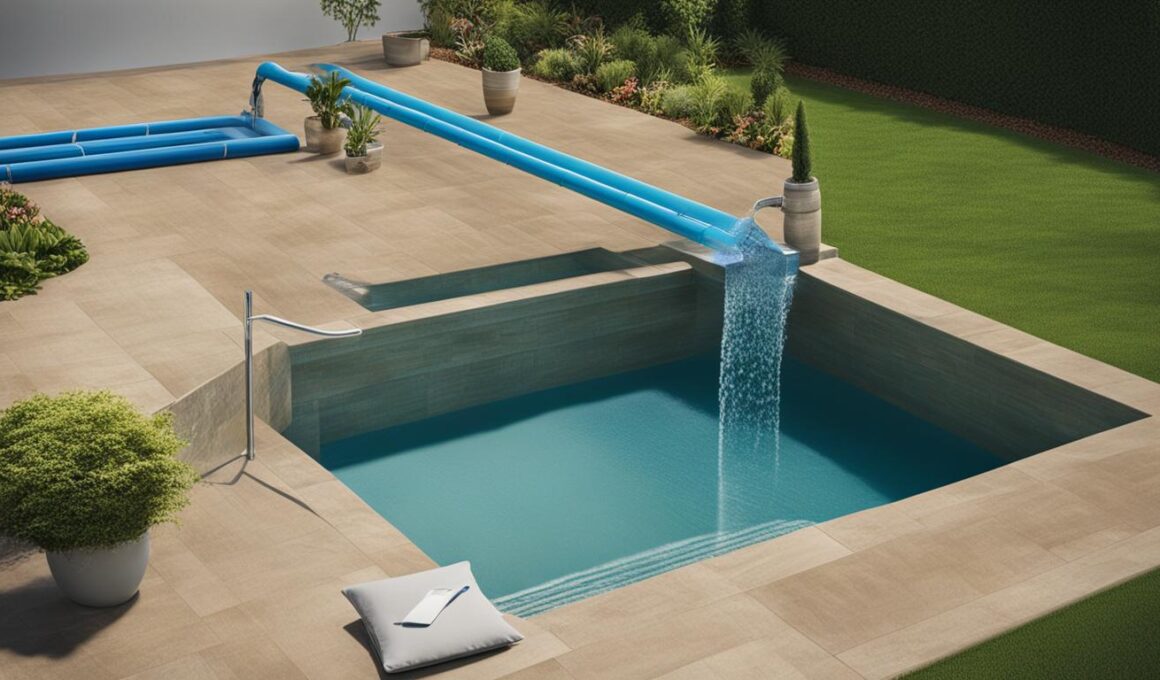Ensuring the perfect balance of chlorine levels in your pool is essential for maintaining crystal-clear water and a healthy swimming environment. Knowing how much chlorine to add to your pool is the key to achieving this balance.
Proper pool water maintenance requires the use of chlorine as it acts as a powerful disinfectant, killing harmful bacteria and germs that can contaminate the water. By regularly testing and adjusting chlorine levels, you can ensure a safe and enjoyable swimming experience.
Why do I need chlorine in my pool?
Chlorine is an essential component of pool maintenance and plays a crucial role in ensuring pool hygiene. When it comes to pool water, bacteria and germs are a constant concern. However, with the help of chlorine, you can effectively eliminate these contaminants and keep your pool water safe and clean for swimming.
Adding chlorine to your pool creates a powerful disinfectant compound known as hypochlorous acid. This compound effectively kills algae, bacteria, and other germs that can contaminate the water. By maintaining proper chlorine levels, you create a safe and enjoyable swimming environment for yourself and your loved ones.
However, it’s important to exercise caution and avoid overuse or misuse of chlorine. Excessive chlorine can lead to health issues such as eye irritation, skin redness, and even respiratory problems. Finding the right balance is key to reaping the benefits of chlorine while avoiding any potential side effects.
By practicing regular pool maintenance and adhering to proper chlorine treatments, you can ensure optimal cleanliness and pool hygiene. Remember, pool safety and enjoyment go hand in hand, and chlorine plays a vital role in achieving both.
The Importance of Hypochlorous Acid
When chlorine combines with water, it forms hypochlorous acid, which serves as a potent disinfectant. This acid is effective in neutralizing bacteria and germs that may enter your pool, ensuring the water remains safe for swimming. Hypochlorous acid is recognized as a highly reliable and widely used sanitizer in the pool industry.
To maintain the appropriate levels of hypochlorous acid in your pool, it’s crucial to monitor and maintain the correct chlorine levels. This will help ensure that your pool water remains crystal clear and free from harmful contaminants.
- Chlorine acts as a disinfectant, killing bacteria and germs in the pool water.
- Maintaining proper chlorine levels is vital for pool hygiene.
- Excessive chlorine use can lead to health issues such as eye irritation and respiratory problems.
- Chlorine forms hypochlorous acid, a potent disinfectant compound.
How much chlorine to add to a pool
The amount of chlorine to add to a pool depends on various factors, including the type of sanitizer used, the sanitation method, the size of the pool, weather conditions, and the frequency of pool usage. These factors play a crucial role in maintaining proper chlorine levels and ensuring a clean and safe swimming environment.
When it comes to chlorine treatments, it’s important to establish the appropriate free chlorine level in your pool. Free chlorine refers to the chlorine available to disinfect the water and kill bacteria and germs. By maintaining the right free chlorine level, you can ensure effective pool sanitation.
For home pools, the following free chlorine level ranges are commonly recommended in parts per million (ppm):
- Minimum free chlorine level: 1 ppm
- Maximum free chlorine level: 6 ppm
- Ideal free chlorine range: 2-4 ppm
- Typical free chlorine range: 3-5 ppm
To determine the ideal chlorine levels for your specific pool size and usage, it’s important to consult professional pool maintenance guidelines, as different types of pools may have specific requirements. Regular testing of chlorine levels and adjustments accordingly will help ensure optimal pool sanitation and a safe swimming experience.
Remember, maintaining the proper chlorine levels in your swimming pool is crucial for crystal-clear water and a healthy swimming environment. By following recommended guidelines and regularly testing and adjusting the chlorine levels, you can enjoy a clean, safe, and refreshing swimming pool all season long.
Is Adding Salt to My Pool an Alternative to Chlorine for Maintaining Proper Levels?
Yes, adding salt to your pool can be an alternative to chlorine for maintaining proper levels. By using salt pool maintenance tips, you can achieve balanced water chemistry and keep your pool clean and safe for swimming. It’s a convenient and effective method for pool maintenance.
Conclusion
Maintaining optimal pool conditions, including pool cleanliness and chlorine levels maintenance, is crucial for creating a safe and enjoyable swimming environment. While chlorine is commonly used to sanitize pool water, it’s important to use it in moderation to avoid potential health risks.
Consider exploring chlorine alternatives, such as Hydroxyl-Based AOP, which can reduce the need for excessive chlorine use while still ensuring optimal cleanliness and protection. These alternative pool sanitation systems can help maintain crystal-clear water while minimizing the potential adverse effects of chlorine.
Regularly testing and adjusting chlorine levels is essential for achieving the perfect balance in your pool. By staying proactive and considering alternative sanitation methods, you can enjoy a safe and inviting swimming experience all summer long. Remember to prioritize pool cleanliness and maintain optimal pool conditions for a refreshing and worry-free swimming environment.









